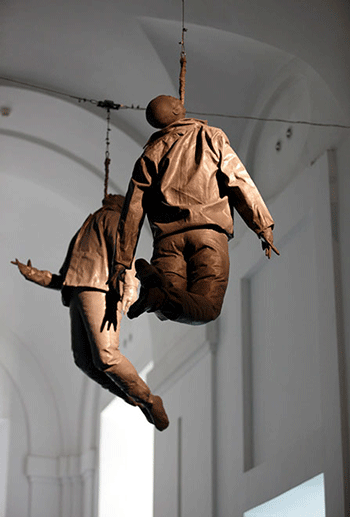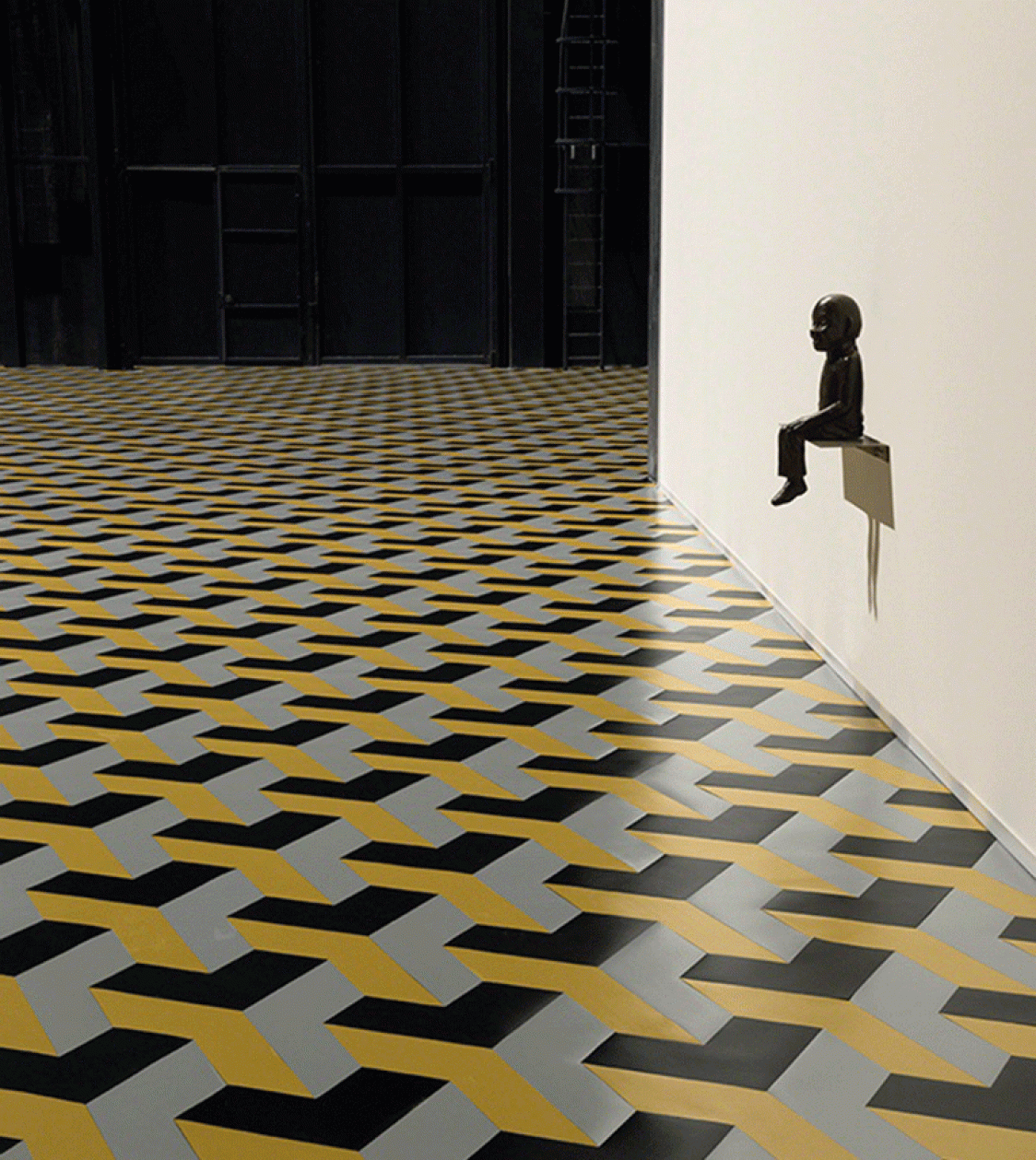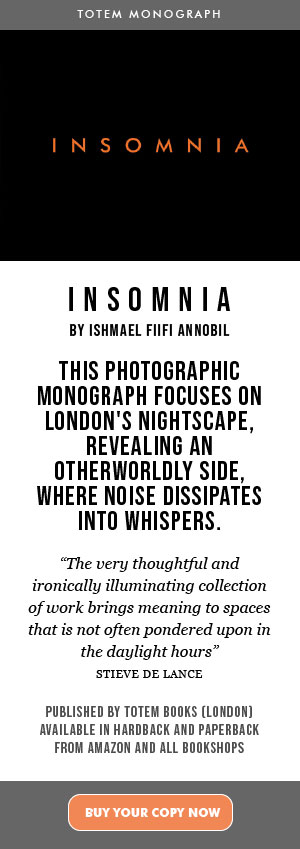JUAN MUÑOZ: DOUBLE BIND & AROUND
HangarBicocca
9 April – 23 August 2015
HangarBicocca, the contemporary art space promoted by Pirelli, presents Double Bind & Around, the first solo exhibition in Italy devoted to Juan Muñoz and curated by Vicente Todolí.The exhibition covers 5,300 square meters of the nave and aisles of HangarBicocca and, includes 15 works (with over 100 sculptures) by one of the most important artists of our time.
It comprises his most significant works, including The Wasteland (1986), Waste Land (1986), Ventriloquist Looking at a Double Interior (1988-2000), Conversation Piece, Dublin (1994), The Nature of Visual Illusion (1994-1997) and Many Times (1999).The exhibition  centres on his most significant work, Double Bind, an installation made in 2001 for the Turbine Hall at Tate Modern in London. It is now being shown again for the first time since then.
centres on his most significant work, Double Bind, an installation made in 2001 for the Turbine Hall at Tate Modern in London. It is now being shown again for the first time since then.
Defined as one of the most complex and unique contemporary artists, Juan Muñoz saw himself as a "storyteller".One of the most important artists to emerge in Spain after the Franco dictatorship, he was a visionary who placed the human figure at the centre of his art. His alienating settings and fictitious worlds inhabited by bizarre characters such as acrobats, ventriloquists, ballerinas and solitary dwarfs, give rise to countless possible narratives.
"Sculpture twists the space it occupies, squeezing it from edges to middle, in all its extension, like a sheet that flaps in the air before being laid on the table-floor" (from Juan Muñoz, "Writings/Escritos", edited by Adrian Searle, Ediciones de la Central, Madrid 2009).
Fascinated by Roman statues and by seventeenth-century Baroque architecture (he spent a year in Rome in 1991), Juan Muñoz investigated the relationship between the human figure and the exhibition setting. He explored new ways of distorting space, using daring perspectives and variations in scale, not just to engage the viewer's at the level of perception and the senses but also, and especially, to create a psychological tension within the individual who interacts with the work.
Juan Muñoz; Many Times, 1999
His interest in the art of illusion led him to convey a powerful sense of ambiguity and enigma, in which the boundaries between reality and fiction are blurred, creating an increasingly complex play of contradictions and paradoxes.
The artist thus broadened his field of investigation to the emotions and to a greater psychological interaction with the viewer, and he did so by working with the languages of sculpture, architecture, drawing, installation, sound and writing, using references to the cinema and photography, as well as magic.
The Double Bind installation is the most significant work created by the artist, who died in 2001 aged 48, just a few months after presenting it to the public. Designed for and shown in the Turbine Hall as part of the Unilever Series at Tate Modern (London, 2001), it has never been reconstructed since.
Double Bind is now being represented - adapted to fit an area of 1500 square metres - and exploiting the vertical volumes of the former industrial space of HangarBicocca. Consisting of a series of dark scenarios with architectural elements that play on the contrast between the visible and the invisible, reality and illusion, in structural terms it consists of three floors and two constantly moving elevators. From the top floor, the visitor can look out over a surface of geometric forms, which contains holes or shafts that may be real or illusory.
On the intermediate level, on the other hand, figures appear, alone or in groups, locked into poses that belong to an indefinite space-time dimension. Muñoz creates an aseptic architectural world, using structural elements such as barred windows and gratings. It is the artist himself who defines the viewers' experience, as though they were in a city rather than a museum (from Double Bind at Tate Modern, Tate Publishing, London 2001).
The Double Bind & Around exhibition as a whole modifies the HangarBicocca spaces, and brings together some of Juan Muñoz's most important works, including The Wasteland (1986), with a floor made of coloured geometric patterns and a ventriloquist's dummy sitting on a shelf, Waste Land (1986), in which the ventriloquist is placed on a wall above an optical floor, and Many Times (1999), which consists of a "crowd" of figures with oriental features and caustic grins arranged around the space.
There are also a number of Conversation Pieces dating from the early 1990s. These consist of anonymous figures arranged in equally generic spaces. The characters, whose shape makes them look vaguely human, have spherical structures in place of legs. Each figure occupies the space in a different pose, conversing, observing or listening to facts and events that are unspoken, and thus incomprehensible to the viewer. The characters in Hanging Figures (1997), on the other hand, are shown in implausible poses as they flutter like acrobats in the air. This work is inspired by Miss La La at the Cirque Fernando, an 1879 masterpiece by Edgar Degas, which shows an acrobat in a daring perspective from below.
Juan Muñoz (1953 - 2001)
Juan Muñoz was born in Madrid, the second of seven children. He grew up under the Franco regime and in the mid-1970s moved to England, where he studied at the Central School of Art and Design and at the Croydon college of Design and Technology in London, the city where he met his future wife, the artist Cristina Iglesias. During his career he encountered many artists, including Richard Serra and Mario Merz. However, even though he knew of Minimalism and Arte Povera, he opted to go in a diametrically opposite direction, which led him to assert a form of art like no other in contemporary sculpture.
Known mainly for his sculptures in papier mâché, resin and bronze, Juan Muñoz often took an interest also in the sound art, creating compositions for the radio and audio pieces. He also wrote intensely and some of his writings have been published in catalogues, newspapers and magazines - including Domus and Figura - and he worked with musicians and actors on sound performances, some of which will be presented at HangarBicocca.
Retrospective exhibitions have been devoted to his work by leading institutions, including Hirshhorn Museum & Sculpture Garden, Washington DC (2001), Museum of Contemporary Art, Los Angeles (2002), The Art Institute of Chicago (2002), Contemporary Arts Museum, Houston (2003), Musée de Grenoble, Grenoble (2007), Tate Modern, Londra (2008) and Museo Nacional Centro de Arte Reina Sofía, Madrid (2009).
The HangarBicocca exhibition programme
Double Bind & Around is part of the programme of exhibitions curated by artistic director Vicente Todolí together with curator Andrea Lissoni. The 2015 calendar of HangarBicocca will continue with exhibitions by Damián Ortega (11 June – 8 November 2015) and Philippe Parreno (October 2015 – February2016).
HangarBicocca and Pirelli
HangarBicocca, the Pirelli contemporary art space, is the natural continuation of the long commitment to culture, research and innovation that has been a key feature of the company ever since it was founded over 140 years ago. Thanks to the support of Pirelli, HangarBicocca offers the public a prestigious programme and a whole series of activities for children and families, making it a centre of attraction for Milan and for an international public.
Fondazione HangarBicocca
Via Chiese 2, 20126 Milano
T (+39) 02 66 11 15 73
F (+39) 02 64 70 275
info@hangarbicocca.org / www.hangarbicocca.org
Opening times: Thursday–Sunday, 11 a.m.-11 p.m.
Admission: Free
Workshops: Every weekend, for children (11.15 a.m.–3.30 p.m.)
Info for the public : +39-0266111573/
Image Credits:
1. Juan Munoz, The Wasteland, 1986
2. Con la corda alla bocca, 1997



